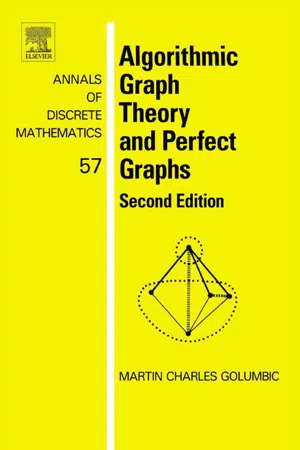
- 340 pages
- English
- ePUB (mobile friendly)
- Available on iOS & Android
Algorithmic Graph Theory and Perfect Graphs
About this book
Algorithmic Graph Theory and Perfect Graphs, first published in 1980, has become the classic introduction to the field. This new Annals edition continues to convey the message that intersection graph models are a necessary and important tool for solving real-world problems. It remains a stepping stone from which the reader may embark on one of many fascinating research trails.The past twenty years have been an amazingly fruitful period of research in algorithmic graph theory and structured families of graphs. Especially important have been the theory and applications of new intersection graph models such as generalizations of permutation graphs and interval graphs. These have lead to new families of perfect graphs and many algorithmic results. These are surveyed in the new Epilogue chapter in this second edition.- New edition of the "Classic" book on the topic- Wonderful introduction to a rich research area- Leading author in the field of algorithmic graph theory- Beautifully written for the new mathematician or computer scientist- Comprehensive treatment
Frequently asked questions
- Essential is ideal for learners and professionals who enjoy exploring a wide range of subjects. Access the Essential Library with 800,000+ trusted titles and best-sellers across business, personal growth, and the humanities. Includes unlimited reading time and Standard Read Aloud voice.
- Complete: Perfect for advanced learners and researchers needing full, unrestricted access. Unlock 1.4M+ books across hundreds of subjects, including academic and specialized titles. The Complete Plan also includes advanced features like Premium Read Aloud and Research Assistant.
Please note we cannot support devices running on iOS 13 and Android 7 or earlier. Learn more about using the app.
Information
Graph Theoretic Foundations
Publisher Summary
1 Basic Definitions and Notations
Functions and Relations




Table of contents
- Cover image
- Title page
- Table of Contents
- Copyright page
- Dedication
- Foreword 2004: The annals edition
- Foreword
- Preface
- Acknowledgments
- List of symbols
- Corrections and errata to: Algorithmic graph theory and perfect graphs, the original 1980 edition
- Chapter 1: Graph Theoretic Foundations
- Chapter 2: The Design of Efficient Algorithms
- Chapter 3: Perfect graphs
- Chapter 4: Triangulated graphs
- Chapter 5: Comparability graphs
- Chapter 6: Split graphs
- Chapter 7: Permutation graphs
- Chapter 8: Interval graphs
- Chapter 9: Superperfect graphs
- Chapter 10: Threshold graphs
- Chapter 11: Not So Perfect Graphs
- Chapter 12: Perfect Gaussian Elimination
- Appendix
- Epilogue 2004
- Index